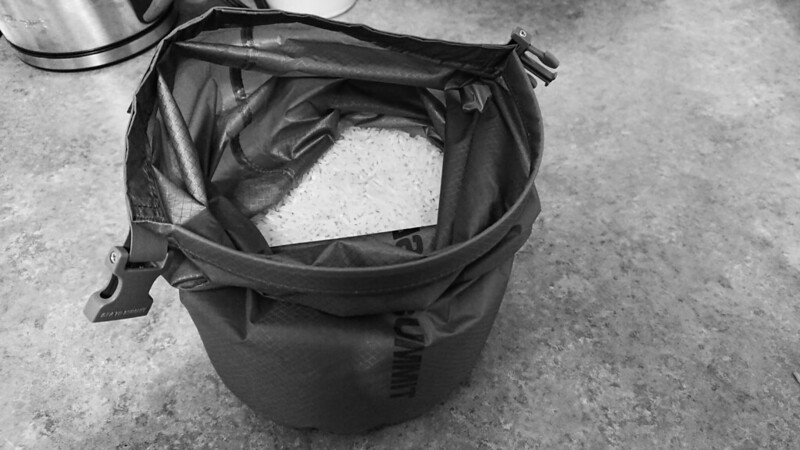Instant miso is appropriate for wilderness travel, where weight is a primary concern and there is a multi-day absence of refrigeration. Outside of activities with those restrictions, I prefer to avoid it. One of the key advantages to miso is that it is a probiotic, containing living cultures. With dry, instant miso that advantage is lost.
When I want miso on the go, I’ll prepare a serving using the same ingredients I’d use to make miso at home. This seems like an obvious solution, but it hadn’t occurred to me until I saw it on Just One Cookbook. The author of that recipe stores the mixture in the container that she plans to eat the soup out of. I didn’t want to carry around a container that large, and I already keep a mug at work for my daily Standard Issue Oatmeal and kukicha. Instead, I store the ingredients in a Sistema Klip It 1520 – the same container I use for my oatmeal capsules.

My Mobile Miso Capsule contains:
- 1 tablespoon of miso paste
- 1/2 teaspoon of dashi powder
- 6 to 12 pieces of wakame
- Around 1/4 teaspoon of umeboshi furikake
- Half a scallion, chopped
I keep things interesting by pedaling over to Nijiya in Japantown and purchasing random tubs of miso paste with labels that I usually cannot read, so I have no particular recommendation there.
The measurements are rough. As a general rule of thumb, a single serving of miso is considered to be 200 milliliters of water and 1 tablespoon of miso paste, but I use a little more water and the amount of miso paste needs to be adjusted based on your tastes and the strength of the particular tub of paste you’re using.
When refrigerated, this preparation will last for a week. It can keep at room temperature for a day. I can make 5 capsules over the weekend, and each weekday morning grab one out of the fridge to throw in my pack before heading out. I do this most weekdays, and end up fueling with the miso mid-afternoon, at around 15:00. None of these ingredients need to be cooked, so the final preparation is simple. It requires only hot water:
- Open the capsule and dump the contents into a mug.
- Pour about 300 milliliters of hot-but-not-boiling water over the top.
- Stir the contents for about 30 seconds.
- Let sit for a couple minutes.
- Consume.
The end result is predominantly drunk. A utensil (spork, spoon, chopsticks) is useful for transferring the ingredients to the mug, stirring, and for getting the last bits of wakame and scallion into your mouth.
As with my Standard Issue Oatmeal, this recipe makes a good base to which other items can be added. Sliced mushrooms – dried or fresh – are a good addition. The original recipe from Just One Cookbook included aburaage. Thinly sliced and diced carrots are another idea. Between these types of additions and the variety of miso pastes available, it is easy to keep this soup interesting, which is a characteristic I value in a daily fuel.
Dashi
The instant dashi powder used in this recipe is my deference to the mobile nature of the meal. Miso without dashi is blasphemous. I don’t want to carry around a liquid, so fresh dashi is out. Apparently miso paste with premixed dashi is a thing, but I’ve never tried it. I have experimented with a handful of different dashi powders.
Ajinomoto Hondashi is the first powdered dashi I tried. It comes in a jar and is simple to use. It does contain monosodium glutamate (which should go without saying as Ajinomoto is the company Dr. Ikeda created to market his discovery of MSG). This partially explains its deliciousness, but of course the only reason to include monosodium glutamate is because they aren’t using actual kombu and so need to get their glutamate from some other source. The ingredients are: salt, monosodium glutamate, lactose, sugar, dried bonito tuna powder, disodium inosinate, bonito extract, yeast extract, and disodium succinate.
Kayanoya Original Dashi Stock Powder comes in packets that are intended to be placed into 400 milliliters of water, boiled for a couple of minutes, and then discarded. I like the flavor of these packets, but the preparation method isn’t compatible with my capsules: I want to mix all the ingredients beforehand, I’m pouring less-than-boiling water over everything, and I’m only making a single serving with about 300 milliliters of water. I’ve tried opening the packet and adding half of the powder to one of my capsules. The resulting flavor is smooth, but very weak, and the powder does not disolve completely. I think this dashi powder really does need to be boiled briefly to extract its flavor. The ingredients are: raw flavor materials (dried bonito flakes, dried sardine extract powder, roasted flying fish, dried round herring flakes, kelp), starch hydrolysate, yeast extract, salt, soy sauce powder, and fermented seasoning (soy, wheat, vegetable starch, brewer’s yeast).
Nijiya Wafu Dashi is one of the good ones. Like the Kayanoya, it comes in individual packets, but the packets are not intended to be steeped. You rip open the packet and dump out the contents. One packet holds about one teaspoon, which to me is appropriate for two miso servings. I split the packet between two capsules. The ingredients are: sugar, salt, glucose, dried bonito powder, yeast extract powder, bonito extract powder (bonito extract, tuna extract), shiitake mushroom extract powder, and kelp powder.


